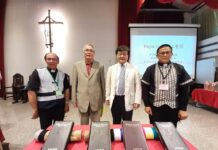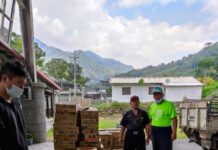|
Taiwan Church News 3050 Edition August 9~15, 2010
Typhoon Morakot victims remembered in various ways on August 8
Reported by TCN staff reporters Written by Lydia Ma Photo by Sam Lee, Lin Yi-ying
PCT holds memorial service to honor victims
2,228 PCT members gathered at National Nei-Pu Senior Agricultural-
Christians prayed for rebuilding efforts, emotional healing of Morakot survivors, and PCT’s role in both. They also encouraged one another to continue supporting post-Morakot rebuilding efforts through prayers and financial donations.
PCT General Assembly Moderator Rev. Lai Hsien-Chang gave the sermon. He underscored that our first step is to repent and seek God’s forgiveness for our role in environmental degradation. Next, we must be still, pray, and listen to God’s voice, for it’s through quietness and time that we will find healing and strength. Finally, we must work through this ordeal together as a unified nation.
Rev. Ngerel from Paiwan Presbytery shared about Typhoon Morakot’s impact on his presbytery. He recalled that as his congregation got ready to celebrate Father’s Day on August 8 last year, heavy rains followed by landslides had washed away or inundated many people’s homes.
As a pastor, he and his family braved the rainstorm to visit and comfort his congregation and other residents in his village. Together, they prayed and cried out to God for 7 consecutive days, pleading the rain would stop and praying for God to protect Aborigine villages.
“Morakot helped me experience the amazing power of prayer. Though our reservation was damaged, no one was hurt and no one perished. Thank God!” Ngerel said.
Elder Lai Tsung-ming from Kudrengere Church in Rukai Presbytery recalled that water levels in nearby rivers rose and covered Kudrengere in Wutai Township near Pingtung County on August 7 of last year. Both of his parents perished in the flood that followed and a helicopter that’d been dispatched to rescueKudrengere residents crashed in the mountains, killing all rescue workers aboard.
In the brink of death, Lai learned to depend on God for strength. The flood strengthened his faith and renewed a sense of solidarity among people in his community. Those rescue workers who lost their lives trying to save others would always be remembered as heroes by Aborigines, he said.
Aborigines stage overnight rally and light bonfire in protest
Besides this music service, Indigenous Peoples Action Coalition of Taiwan (IPACT) staged an overnight, “sleep-in” protest in front of the Presidential Palace to voice concern over post-Morakot rebuilding policies.
A small band of elementary school children from NamasiyaTownship wore headbands with the words, “No to forced relocation! No to division!”, and carried signs inquiring, “Mr. President, what happened to our elementary school?”. Their presence caught the attention of reporters on the scene.
Some Aborigines complained that a few police officers working in their reservations had lied by telling them the rally at Ketagalan Boulevard was illegal and had been orchestrated by a shady organization. Other Aborigines reported the Ma administration had deliberately fueled internal strife and division among Aborigines in the aftermath of the typhoon through policies.
The rally began after Tsou, Taroko, Atayal, and Amis pastors led the crowd in prayer in their own languages. PCT Associate General Secretary Sing ‘Olam prayed for God to open President Ma’s eyes and ears to see and hear the cries of Morakot victims so that he’d be convicted and govern responsibly. He also prayed for God’s mercy on Morakot victims so that they’d regain their carefree spirit as they journey on this road toward recovery.
PCT General Secretary Rev. Andrew Chang was also present at the rally and spoke with uncharacteristic passion. “The road back home is very hard. Our demands are very simple and we’ve waited one year. We ask President Ma to give us an answer,” he said.
Aborigines voiced their stark opposition to permanent housing units as quick fixes and urged government officials to include Aborigine leaders in policy planning. Their appeals seemed to fall on deaf ears as the Executive Yuan’s Reconstruction Council reiterated it’d done its best, to the disappointment of Morakot victims.
Experts slam wrongheaded policies
Former Council of Indigenous Peoples Minister Walis Pelin accused the government of lying to Aborigines. He explained that 83% of the budget allotted for post-Morakot rebuilding had already been approved, but merely 6.78% had been spent so far.
He claimed 3,423 applications for permanent housing units had been received, but only 2,119 had been approved. In other words, 1,304 applications had been left unaccounted for. Out of the 2,119 approved applications, only 1,127 families managed to secure permanent housing. Apparently another 1,000 or so applications were unaccounted for again.
Walis Pelin reminded the public that Aborigines moving into permanent housing were forced to sign away rights to the land of their ancestors in exchange. This condition prompted many Aborigines to decline permanent housing units. “This government policy is anti-humanitarian!” he said.
Another former Council of Indigenous Peoples Minister Yohani Isqaqavut recalled when he visited a friend inNamasiya two weeks ago, he was discouraged from entering the village because his friend was afraid he’d be stuck in the mountain if it rained. Another time, while visiting an Aborigine reservation in Alishan area, he wondered whether the roads he saw were made for humans or for mountain pigs.
During a conference on Typhoon Morakot hosted by Taiwan Association of University Professors on August 6, IPACT convener Rev. Lituan remarked that government policies in the aftermath of the typhoon turned out to be more devastating than the flood itself.
Lituan slammed Tzu Chi Foundation and bureaucrats for placing blame on Aborigines for this natural disaster and forcing them to leave their homes under the pretext that forests needed rest from exploitation. He berated them for lack of introspection and failing to see the results of excessive, though legal, logging policies that’d precipitated landslides.
He referred to recent water diversion projects to re-channel water from Tseng-Wen Reservoir to Nan-HuaReservoir as examples of anti- environmentalism on the part of the government. “When mountains are blasted to make way for construction, we can literally feel the mountains moving,” he said.
As an Aborigine who lost his home to Typhoon Morakot, PCT Youth Ministry Committee Secretary ItanPavavalong has already filmed a documentary featuring Aborigines’ forced relocation. He remarked that personally visiting many reservations had enabled him to truly understand how government rebuildingpoliciess had torn the social fabric of Aborigine reservations.
|








